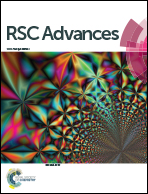Preparation of 2-phenyl-3-hydroxyquinoline-4(1H)-one-5-carboxamides as potential anticancer and fluorescence agents†
Abstract
The synthesis of 3-hydroxyquinoline-4(1H)-one derivatives bearing substituted phenyl in position 2 and variously substituted carboxamide group in position 5 is described, with use of 3-nitrophthalic anhydride, α-haloketones and primary amines as the starting materials. The synthetic approach was inspired by the preparation of analogous derivatives reported previously. However, a different strategy had to be developed with the corresponding bis(phenacyl)-3-aminophthalates as the key intermediates. Synthesized hydroxyquinolinones, as well as their intermediates, were tested for their cytotoxic activity towards various cancer and non-malignant cell lines. The fluorescent properties of these compounds have also been evaluated. In both fields, interesting data were obtained and compared to isomeric compounds that have been studied in the past.


 Please wait while we load your content...
Please wait while we load your content...